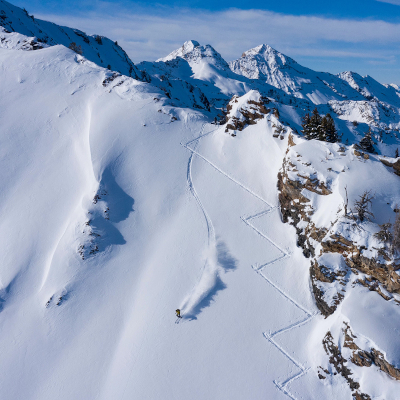Risk Assessment and preparation.
Avalanche Avoidance
The golden rule of back country or off piste skiing and snowboarding is to AVOID avalanches. Everyone should be properly equipped and trained to deal with an avalanche but nobody should ever have to ! The key to safety is Local Knowledge. The problem is that the best slopes to board and ski down are the most avalanche prone. If you are touring then you can plan your route to avoid dangerous slopes but if you are looking for steep powder runs then you are deliberately putting yourself in a dangerous position. Backcountry boarding and skiing is hazardous and you should be aware of the risks. Snowboarding and new ski technology has opened up the backcountry to people with limited alpine experience who treat it as a video game style competition and the avalanche accident rates have risen accordingly! You have as much right to be there as anyone else but everyone should be armed with a healthy fear of avalanches.
1.History
You should be aware of the local conditions before you go out. When did it last snow? Are there any slopes that always avalanche? Has it been warm or cold? How many snowfalls have there been this season? How windy has it been? Have there been many avalanches this season? All these questions give you an idea of the risk you are facing. There is no substitute for local experience and knowledge. You are most at risk just after a snowfall and the more snow that fell the greater the risk.
New snow added in 3 days compared with observed avalanches
Up to 10cm – rare avalanches, mostly loose snow
10 – 30 cm – very occasional slabs, frequent sloughs
30 – 50 cm – frequent slabs on slopes 35 degrees
50 – 80 cm – widespread slabs on slopes down to 25 degrees
2. Slope selection
If you are happy with the general snowpack conditions, you then need to consider the slope or terrain that you wish to use. All faces look fantastic covered in fresh powder but there are some important questions to be answered about each slope.
How steep is it? Below 25 degrees is not steep enough to slide, above 50 degrees is too steep to hold a lot of snow, anywhere between is prime avalanche territory
Is the slope concave or convex? Convex slopes do not support the weight of the snow high up very well and are more prone to avalanche
What is the slopes aspect? North facing slopes are less affected by the sun and colder just after it has snowed, south facing slopes consolidate more quickly and are safer a few days after the snowfall. This is especially true in the springtime where south slopes consolidate quickly and north facing ones can remain dangerous for days or weeks after a snow fall.
Is the snow wind affected? If the wind has been from behind the slope it will have deposited a lot of snow on the slope and given it a pillowed effect. There is now a great weight of snow to be supported and the risk is higher. If the wind was strong as well it may have formed a slab, where the snow has been blasted together in one huge lump. In this case the risk is high and if there is an avalanche it is sure to be a big one. If the wind was up the slope it will be scoured, and most of the loose snow will have been removed , this will be safer but the conditions not as good. A cross slope wind will give both conditions at different places on the slope. The ideal is for the snow to fall in still wind conditions but that happens only when there is a blue moon!
What time is it? How much sun has your slope received today. A slope can be safe at 10.30, dodgy by midday and downright dangerous by 1.30. The avalanche risk changes all the time, just because there are tracks does not mean it is safe!
What is the ‘run out’ like? If your slope fans out into a wide gentle area, an avalanche will slow down and spread out reducing your chances of being completely buried, if it runs into a gully or depression you may be buried under many metres of snow and digging you out could take hours
If your assessment has revealed that the slope is too risky then you must walk away. It is tempting just to say ‘sod it I’m going down’ especially if the snow conditions are good, and you may escape incident this time. But that attitude will eventually get you killed. You can ride many more slopes in ten years safely, than skiing all the slopes all the time until you get killed.
Now you have a good idea of what to look out for, Mammut put together a talk from experts on what to do if you are involved in a rescue. Its a long one, so make a cup of tea and find a comfortable seat;

